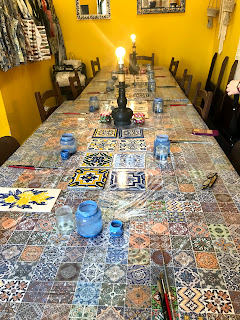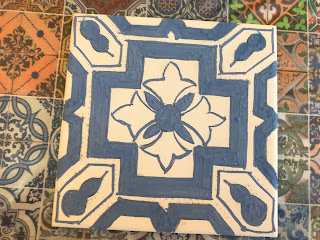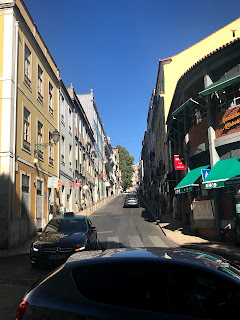One of the things I’ve been most looking forward to on our trip was learning the art of Azulejos. Back in the 13th century, azulejos (tiles) came to Spain and Portugal when the Moors invaded the area but it wasn’t until the 15th century when King Manuel I visited Seville and brought back the idea to Portugal society. The word azulejos come from an Arabic word meaning small polished stone.
At first, it was only the wealthy and churches that could use azulejos to decorate their homes but after the big earthquake of 1755 when most of Lisbon was destroyed, the Marquês de Pombal had the city rebuilt and tiles used for the exterior and interior of buildings as they are excellent insulators as well as they resist fire, rain and other elements of nature. When the tiles are placed on the inside walls, they keep the inside cool in the summer and warm in the winter and when they are placed on the outside, they keep the house cool in the summer as they stop the heat from entering and warm in the winter as they keep the heat inside. Because Pombal needed so many tiles in such a short amount of time, he had convents and prisons assist in the production. With so many tiles being produced, the cost went down and the average person could also use tiles for their homes. And thus, a tradition was born.
After this brief history lesson, our teacher, Caroline, put us to work. Given I have absolutely no artistic ability, I was a bit curious how I was going to be able to create a work of art like the ones I saw in Caroline’s studio. Well, this was not the first time she had worked with people that were clearly not artists and had a great plan for what I affectionately call Azulejos for Dummies. She has over 30 different designs from the traditional geometric designs to more modern designs. Once you pick your design, she gets a tile and places her trace paper with the design on top of it. Next she takes a little pin and pokes holes in the paper following the design. The final step is to take something like a sponge that has granite in it and rubs the trace paper so the granite fills the holes and transfers the design to the tile. Now it is ready for painting.
Caroline showed us the proper technique for holding the fine tipped brush to outline the design. Once you outline with the darker color, you then take a fatter tipped brush and a lighter color and fill in the design. While you are painting, you have to be careful to not rest your hand on the tile because it will smudge the paint and/or take off the glaze that is on the terra-cotta tile. After you have completed all the painting, you get a special eraser tool (aka Azulejo whiteout) and start cleaning up lines and removing any mistakes you made…let’s just say I was doing a lot of scraping and blowing (when you scrape a little spot you have to blow the dust off the tile). When I finished my cleaning up, I asked if it was okay and in typical teacher fashion, Caroline said “are you happy?” Of course, this made me revisit my work upon which I found a few more mistakes. Once I was finally happy with my tile, she tells me to sign and then she takes away so it can go in the box for firing later.
We got to paint two tiles and silly me thought my second would be easier so I got a little more ambitious and picked a design with more rounded lines. Let’s just say, I had a good time but I will most definitely not be giving up my day job anytime soon. I have a whole new appreciation for the tiles I see around town and the craftsmanship it takes to create them. We go back tomorrow to pick up our tiles…I’m sure the magic of Caroline’s oven will make them look spectacular!
Earlier this year, I discovered the Netflix show “Somebody Feed Phil” and am hooked as he is hysterical. If you haven’t seen the show, you should check it out especially if you enjoy foods of the places you visit as I do. One of Phil’s episodes was filmed in Lisbon so after our tile class, we went in search of one of the streets in the episode. Have I mentioned Lisbon (heck all of Portugal it seems) is hilly and it is unseasonably warm? So we hopped a cab and made our way to Rua Nova da Piedade to find La Pizza di Nanna followed by what is by far the best gelato we have had anywhere in the world at Nannarella. La Pizza di Nanna is a tiny pizza joint with no seating but fortunately there is a little park across the street so we could enjoy our pizza and do some people watching.
Since according to Google Maps, most of our walk home was “mainly flat” we opted to walk back. Well, mainly flat is a relative term we quickly discovered. But given the pizza and gelato, we needed to do some walking uphill.
We had our first Eatwith dinner in Lisbon tonight with Maria. Joining us was a couple (Joan and Ron) from California that have been traveling in Europe for a little over a month. Maria was a gracious host and welcomed us with a little meat and cheese platter along with some very tasty Portuguese -style gazpacho…and of course wine.
For our entrée, we had tomato and onion salad and duck rice. Maria makes her duck rice a little different than Dixa did in Porto…she adds a little cabbage as she said it makes it more moist. For dessert, we had Pão Lo…similar to angel food cake.
What a fun and educational day!
Até logo



























No comments:
Post a Comment